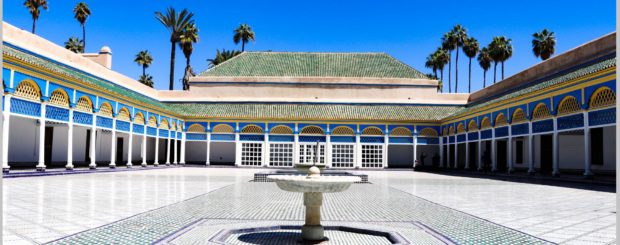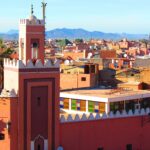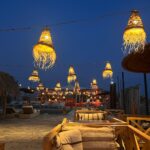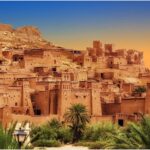Bahia Palace Marrakech
Bahia Palace is a beautiful palace located in Marrakech, Morocco. It was built in the late 19th century and is known for its stunning architecture and beautiful gardens. The palace was built for Si Moussa, a former slave who became a prominent member of the royal court, and was later expanded by his son, Bou Ahmed.
Bahia Palace features beautiful courtyards, gardens, and rooms decorated with intricate tilework, carved wood, and stucco plaster. Some of the highlights include the Grand Courtyard, the Council Chamber, and the Harem.
Visitors to Bahia Palace can explore the palace’s many rooms and gardens, and admire the beautiful architecture and decoration. There is also a small museum on site that displays traditional Moroccan clothing, textiles, and artifacts.
Bahia Palace is open daily from 9:00 am to 4:30 pm, and the entrance fee is 10 MAD (approximately $1 USD) per person. It is a popular attraction in Marrakech and is definitely worth a visit for anyone interested in history, architecture, or just looking for a beautiful place to explore.
Bahia palace history
Bahia Palace was built in the late 19th century by Si Moussa, a former slave who rose to become a prominent member of the royal court in Morocco. Si Moussa was a vizier to the sultan and served as the Minister of War and Agriculture during his career.
Si Moussa built the palace as a residence for himself and his family, and it was later expanded by his son, Bou Ahmed. Bou Ahmed was also a vizier to the sultan and played an important role in Moroccan politics during his lifetime.
The palace was named “Bahia” after Bou Ahmed’s favorite wife, who was known for her beauty and intelligence. Bahia Palace was used as a royal residence during the early 20th century, and it was also used to receive foreign dignitaries and ambassadors.
After Morocco gained independence in 1956, the palace was left unoccupied for several years before being converted into a museum in the 1990s. Today, Bahia Palace is open to the public and is one of the most popular tourist attractions in Marrakech. It is known for its stunning architecture, beautiful gardens, and rich history.
Bahia palace Architecture
Bahia Palace is a stunning example of Moroccan architecture and design, showcasing a mix of Islamic and Moroccan styles. The palace is made up of a series of interconnected courtyards, gardens, and buildings, covering an area of approximately 8 hectares.
One of the most impressive features of Bahia Palace is its intricate tilework, stucco carvings, and painted wooden ceilings. The palace’s central courtyard is particularly striking, featuring a central fountain and surrounded by trees, plants, and flowers.
The rooms and galleries surrounding the courtyard are decorated with colorful tilework and intricate stucco carvings, showcasing the attention to detail and craftsmanship that went into the palace’s construction.
The private apartments of the sultan’s wives and concubines are located on the upper floors of the palace and feature ornate wooden ceilings, colorful tilework, and luxurious furnishings.
Overall, Bahia Palace is a testament to the rich cultural heritage and artistic traditions of Morocco, offering visitors a glimpse into the country’s vibrant history and architectural legacy.
Si Mousa
Si Moussa was a prominent figure in Moroccan history during the 19th century. He was born in Marrakesh in 1826 and rose to prominence as a powerful advisor to the Moroccan sultan, Mohammed IV.
Si Moussa was known for his shrewd political acumen and diplomatic skills, and he played an important role in negotiating treaties with European powers during a time of great political upheaval in Morocco. He also served as the governor of Marrakesh and was responsible for overseeing many of the city’s construction projects, including the building of the Bahia Palace.
Si Moussa’s legacy lives on through his contributions to Moroccan history and his role in shaping the country’s cultural identity. The Bahia Palace, which was built under his supervision, remains one of the most impressive examples of Moroccan architecture and design, and is a testament to the enduring legacy of Si Moussa and his impact on Moroccan culture and society.
FAQs about Bahia Palace
What are the opening hours of Bahia Palace?
Bahia Palace is open daily from 9:00 am to 5 pm.
What is the entrance fee for Bahia Palace?
The entrance fee for Bahia Palace is 70 MAD (approximately $7 USD) per person.
Is there a dress code for visiting Bahia Palace?
There is no strict dress code for visiting Bahia Palace, but it is recommended to dress modestly out of respect for the local culture.
















